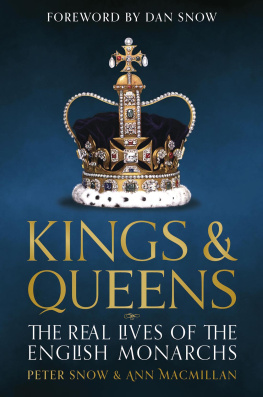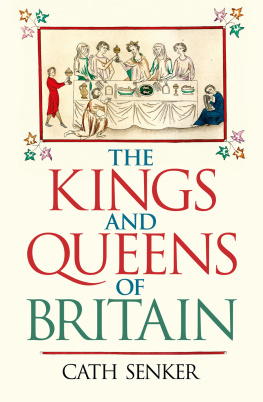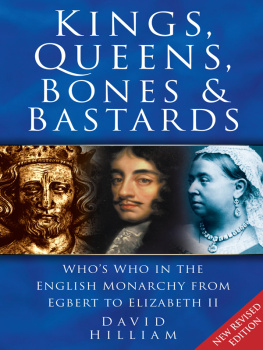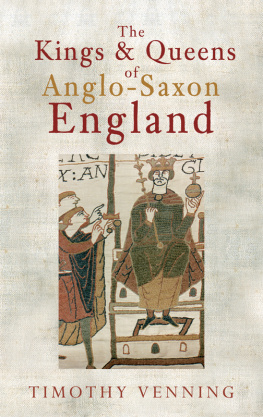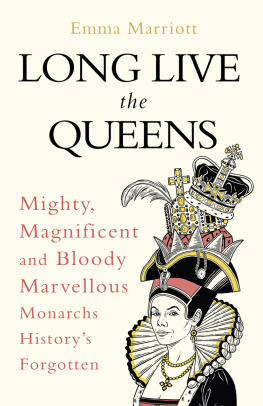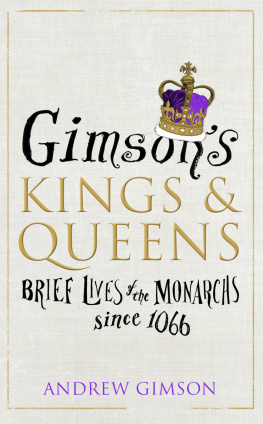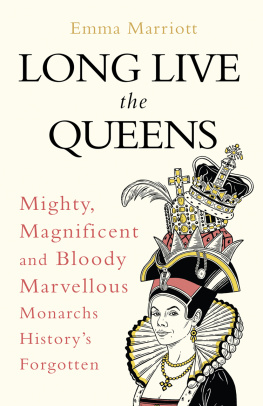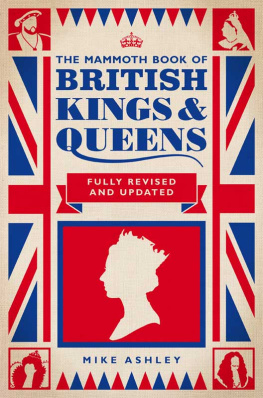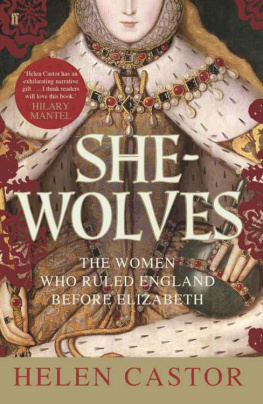ALFREDS SUCCESSORS
899924
Alfreds immediate successors were some of Britains finest monarchs. With the glaring exception of King Eadwig, who reigned for four years from 955, the seven Anglo-Saxon monarchs who ruled for 75 years after Alfreds death brought all of England under a single crown. They built on his legacy of judicious administration and the expansion of learning. It wasnt until the time of Alfreds great-great-grandson Ethelred, the so-called Unready, that Anglo-Saxon England began to fall apart. The pity is that robust and wise as they were, few of Alfreds successors lived long, most dying in their twenties or early thirties. Its a confusing list of up to 10 names beginning with A or E or, most accurately, (see earlier note), but the country thrived until the Anglo-Saxon grip on power took a nosedive under Ethelred the Unready.
Alfreds second child, Edward the Elder, who fought the Danes with his father, became king in 899. He married three times and had 14 children, three of whom sat on the throne. Edward was said to be a gentle, liberal-minded and well-read young man but perfectly capable of baring his teeth when his realm was under threat. He had to start early. His first cousin, Athelwold, the son of Alfreds predecessor as king, had long resented being passed over as an infant, and now demanded the throne he reckoned hed been cheated of. Edward raised an army and penned up Athelwold in Wimborne, where his rebel cousin promptly kidnapped a nun and then sneaked off to take refuge with the Danes in Northumbria. Athelwolds revolt came to a humiliating end when he and the Danes tried and failed to defeat Edwards supporters in Kent at the Battle of the Holme in 902.
From then on, unchallenged in Wessex, Edward waged a triumphant war with the Danes in close alliance with his sister Athelflaed, the Lady of the Mercians, who was now a veritable Joan of Arc, leading her troops into battle. By 910, the Danes had been decisively defeated at the Battle of Wednesfield and brother and sister went on to advance deep into the Danelaw. She captured Derby and Leicester. He pressed on into Essex and built a fort at Maldon. When Athelflaed died in 918, Edward assumed the sole kingship of Mercia. Just to be safe, he took the prudent but heartless step of sending Athelflaeds daughter off to a nunnery in Wessex.
That same year, Edward went on to occupy all of England up to the Humber. The Danes were down, but far from eliminated. In 921, two Danish warlords, Ragnall and Sihtric, even managed to establish a short-lived regime in York and Lincoln. And Edward was not unchallenged in Mercia. There was anger at the way he had sidelined Athelflaeds daughter, and the Mercians may also have resented the imposition of the new Wessex-style shires to replace the age-old Mercian regions. All this helped promote the rebellion Edward faced in Chester in 924. But this doughty successor to King Alfred died soon after he had crushed the rebels.
17 July2 August 924
The next Anglo-Saxon king rivalled only Lady Jane Grey 600 years later for the brevity of his reign. It lasted 16 days. Some believe that when Alfweards father Edward the Elder died, he intended to split his kingdom with his eldest son, Athelstan, inheriting Mercia, where he had been educated while Alfweard, Athelstans younger half-brother, would become the king of Wessex. Athelstan, who was anything but faint-hearted, was unlikely to accept losing half the kingdom he could claim was rightly his. Conveniently, his bothersome brother died only a couple of weeks after his father and before he could be crowned. There is no evidence that he was murdered but it is certainly suspicious that he died at Oxford just as he was embarking on a first visit to Athelstans Mercia.
92439
The man who was now the unchallenged king had been the apple of his grandfather Alfreds eye. Athelstan was only a young lad when Alfred died, but Alfred had sensed his grandsons promise and given him a magnificent scarlet cloak, jewelled belt and Anglo-Saxon sword with a gilded scabbard. Athelstans father had asked Athelflaed, the Lady of the Mercians, and her husband to arrange for Athelstan to be schooled at their court. Athelstan soon accompanied his Mercian patrons in their battles with the Danes and became an esteemed warrior. He was of average height and slim build, and according to the medieval chronicler William of Malmesbury, had fair hair beautifully intertwined with golden threads.
There was a curious gap of more than a year before Athelstan was crowned king of Wessex in 925. The Bishop of Winchester absented himself from the ceremony and there was a clear preference in some Wessex hearts for Athelstans younger half-brother Edwin. He backed a failed conspiracy against Athelstan, and it was some time before Athelstan became widely accepted in Wessex. When Edwin was drowned a few years later, there were suspicions that it was not an accident.
Many of his subjects may have felt uneasy about Athelstan at first, but he was soon recognized as a military champion in the war with the Danes. He reabsorbed Northumbria into Anglo-Saxon England and by the 930s, he was deep inside Scotland. His greatest victory was the crushing of the Danes and Scots at the Battle of Brunanburh in 937. No one knows the exact location, but the Anglo-Saxon Chronicle tells us, Never was a greater slaughter of a host made by the edge of the sword since the Angles and Saxons occupied England four centuries earlier. Athelstans prowess set him on something of a pedestal in Western Europe, where he was regarded as a major power with the whole of England at his feet. He made the most of his reputation and influence abroad by pursuing a lively diplomacy and promoting English trade and the increasingly respected national coinage. He also entrenched the Christian Church as a central bulwark of his governance. Bishops were among his most trusted advisers, and he was a generous supporter of the drive to build monasteries throughout the kingdom. Athelstans promising reign was another short one, ending with his death in 939, when he was in his early forties.
93946
Athelstan was succeeded by another half-brother, Edmund, son of Edward the Elders third wife, a forceful woman called Eadgifu. He seems to have been Athelstans choice. Theyd fought together in the great Battle of Brunanburh, and, although he was only 18, Edmund became king on Athelstans death.
Edmund was a staunch opponent of the Danes, who maintained their pressure, particularly from one Viking stronghold the Irish city of Dublin. Olaf Guthrifson, the king of Dublin, managed to regain the Danish lands around York but, fortunately for Edmund, Olaf died in 941. Edmund went on to ravage Cumbria and humiliate the Scots by blinding the sons of the king of Strathclyde. Alfreds successors may have inherited his love of learning and justice, but they were quite capable of abominable cruelty. Edmund himself was to die horribly in his early twenties at a banquet in Gloucestershire. An outlaw called Leofa had somehow got into the hall, and when Edmund joined others to seize him, Leofa fatally stabbed the king in the stomach.
94655
Eadred was the second of four kings in a row to die in their early twenties or thirties. Like his murdered brother Edmund, he had to face unrelenting pressure from the Danes. One of his most ferocious opponents was a Norwegian warrior prince, Eric Bloodaxe, who held power for a time in York and attacked Eadreds army as it was returning from securing Northumbria. Bloodaxes attack was so savage that Eadred turned his shattered army around and threatened to exact revenge so terrible that the northerners whod supported Bloodaxe switched sides and banished the Norwegian.

